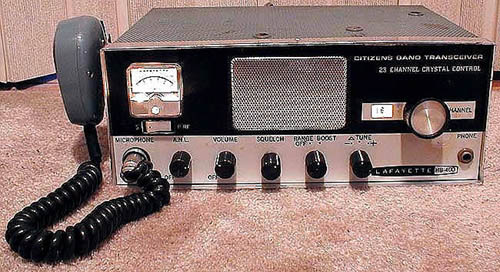
Lafayette HB-400
By Spitfire, 441

The time has come again for another Classic Radio Review. This review is of a vintage tube radio from the mid to late Sixties. This classic tube radio is the Lafayette HB-400.
This radio was an early acquisition for me. It came to me quite by accident really. I went for a ride with a friend of mine who was setting up a base station and wanted a good base antenna quick. So I suggested taking a ride down to R & R Communications in Delaware. While I was there window shopping the merchandise, I didn't think I would be interested in anything they would have in your standard by-the-interstate-type CB shop. Imagine my surprise when, sitting there on the counter, I saw a very clean and in nice shape HB-400. I had them turn it on and put it to an antenna. As it turned out that day, the skip was running and the super bowl was alive with skip, which proved that the receiver worked. The radio also put out about 3 watts with audio on a stock mike. So I did the deal and brought it home.
I have had the radio now a little over a year. In that time I have become very familiar with the care and feeding of these old tube sets. When I first got the radio home and on the air every one said it sounded nice with clean, clear audio. That was good as it is a clean radio in and out. However it seemed to me that the radio should've had a little more audio punch, and greater forward swing power than it had at the start. I didn't really do much to the radio early on except align the receiver and transmitter. The receiver came up real nice and sensitive. This radio had a very nice front end. It uses two Nuvistor type tubes in the first two stages, which makes for a very nice receive with a low noise floor. The receiver chain is then followed by 3 I.F. stages. The audio frequency amp uses a 12AX7 for amplification into a 6BQ5 final output/modulator. This gives the radio that classic full warm receive audio that tube rigs are well known for.
After owning this rig for a while and comparing it to my other restored and tuned up tube rigs, it seemed to me that this radio was just falling a bit short on transmit audio and power output. So I ran through and replaced any tubes less than 80%. That helped a little but didn't solve it. After a lot of probing with voltmeter and oscilloscope it was found that the radio had a fair amount of out of tolerance resistors as well as some leaky capacitors. At least none of them have blown-up on me (yet!) with this rig. Now after a lot of surgery replacing out of tolerance components, which seems to be a theme with tube rigs no matter how good cosmetically, and another realignment of the radio, the rig is now doing what I knew it capable of. With 13 tubes overall and a 6BQ5 output modulator and a separate 6BQ5 RF final tube, I just knew it had more potential. So the lesson learned here is that just because a tube radio works, unless it has been gone over, it's probably not up to its full potential yet.
Ok, so here are my post overhaul/alignment performance numbers: (My own measurements, not the manufacturer's claims):
Receiver:
Sensitivity: .12uV for 10db S+N/N.
Adjacent channel selectivity: 60db @ 10Khz.
I.F. Frequencies: 1st :6Mhz, 2nd 455 Khz
Transmitter:
AM Power: 3 watts.
AM Modulation: 100+%, 8 watts peak. With "Range Boost " on.
2nd Harmonic suppression: -65dbc.
Other spurious emissions: -70dbc
Now that I have had this rig for over a year, it has seen quite a bit of use. The look and feel of this radio suggests to me that this was an upper end rig for its day. I think that now that I have recently got the transmitter back to original specifications, this radio is going to see a lot more air time. The only fly in the ointment now is that my Channel 13 crystal (the Classic Radio Roundup channel) is off frequency. That will have to be taken care of soon. The receiver is right up there with the best. It also has an adjustable ANL circuit. This variable control does a fine job of quieting noise from whatever may be the source. The radio's squelch circuit is a very good performer too. The squelch has a very smooth fade in/out action, without those annoying "thunks" and "pops". The radio's "S" meter is a nice large face linear spaced scale. The action of the meter is very linear too. All signals seem to be properly represented, and easily distinguished. Output power on the radio is read by flipping a switch between "S" or "P/RF". This kind of stinks as you can either read in coming or out going but not both on TX/RX, unless you put the switch in the proper position. Also there is the "Range Boost" feature. It is basically an audio compressor; it does a fine job of it too. You don't want to run without it though as the mike then tends to have somewhat flat audio. This feature seems common on radios of the era. The last control is the variable frequency delta tune. With all the features and quality construction, its no wonder this radio has lasted over 35 years.